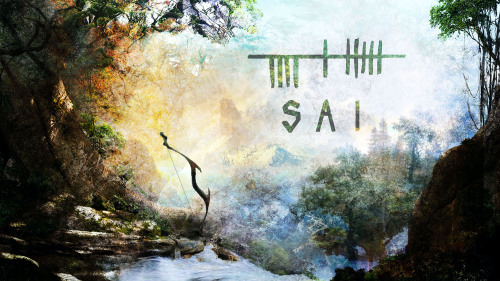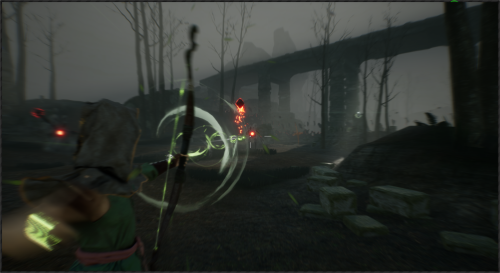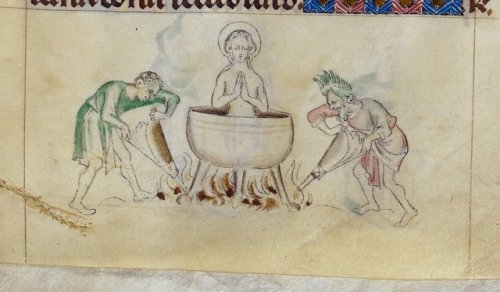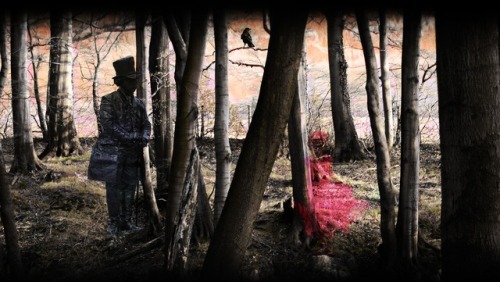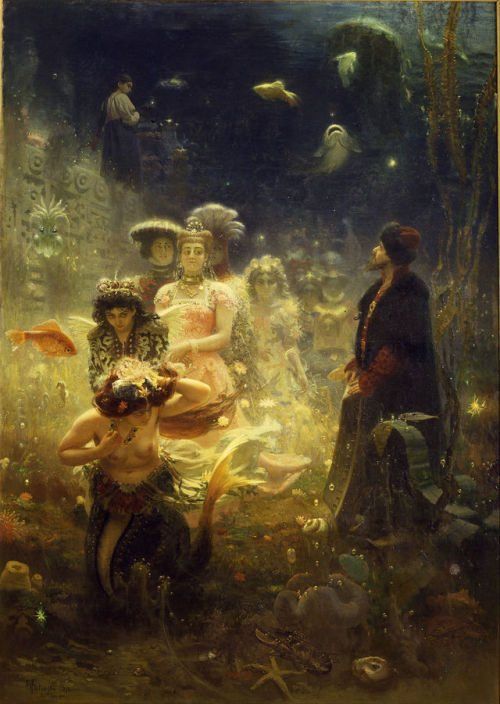#celtic folklore
A supernatural wife never stays…
I’m always extra fascinated by folklore tropes that show up in a wide variety of cultures, so let’s look at another one: the supernatural/inhuman wife. These are usually stories about a man winning himself a wife that is decidedly not human, either through trickery or courtship. But it never lasts, because these stories all seem to have the same ending, the wife leaves:
Almost all selkie stories, both from Celtic and Nordic tradition, are an example of this. A man steals a selkie’s pelt and thereby binds him to her or leaves her stranded on land and in her desperation persuades her to come back with him and become his wife. After many years and many children she always finds her pelt, however, and as soon as she does she runs off to the sea. In most cases it turns out she has a husband and children in the sea too. In most she keeps leaving presents for her children and in some she still feels affection for her human husband, but she never goes back ashore. There are similar tales about swan-maidens.
An Aboriginal story from the Guugu Yimithirr-speaking people called “The forest spirit and his ten beautiful daughters” tells how the great hunter and warrior Gabul, the Carpet Snake, goes to the mountaintop where the powerful Forest Spirit, lives. He bests him in an unarmed fight, demanding to marry one of his daughters as reward before he will let him go. He takes the most beautiful of the ten daughters home to be his wife but starts worrying when she does not eat or drink. Eventually he takes her to the river and there she promptly turns into a fish and swims upstream back to her father’s mountain, leaving Gabul ashamed and broken-hearted.
There are also stories about fairy wives, most notably two from Wales. One, collected as “The Shepherd of Myddvai”, has a shepherd courts a beautiful maiden that dwells in a lake by bringing her bread. She agrees to go with him if he promises not to strike her three times without cause. Of course he promises this, but he taps her once for dallying to spur her into action, once in confusion when she weeps at a happy wedding, and once in disapproval when she laughs at a sober funeral. She declares their marriage ended and flees back to her lake, only returning once her sons are grown to give them gifts of healing.
In the similar tale “Touched by Iron” a farmer’s son falls in love with a fairy maiden and the promise he must make her father is to never touch her with iron. One day as he helps his wife off her horse, she is touched on the knee by the stirrup of the saddle and vanishes. But with her mother’s help she does get to visit him sometimes afterwards, by standing on a large floating turf on a lake, so it could not be said she had set foot on human earth.In a Chinese story called “The Painter”, from the 9th century bundle Wenqi lu, a learned man buys a screen with a painting of an inhumanly beautiful woman on it. The painter tells him of a ritual that might bring the woman to life and the man manages to call her to him. She steps out of the painting and consents to stay with him, they even have a son together. When the child is two years old, however, the man speaks with a friend of his, who immediately suspects the woman of being a dangerous creature and gives him a celestial weapon to kill her. As soon as he arrives home, his companion sobs that she is a mountain spirit who never asked to be painted by the painter and never asked to be called by him. She steps back into the painting, taking her child with her, leaving the man alone with a beautifully painted screen that now shows both her and the little boy.
‘‘ SAI is a third person action game exploring Celtic folklore and deforestation. Set in a magical forest, players will discover an environment damaged and destroyed by onslaughts of machines. These metallic creatures wreck their way through the land to get to the core of its magic, the Heart Tree. Though its presence is now but a lost memory, the machines remain, determined to find this all powerful entity. As a Druid, protector of the natural world, you must explore this beautiful realm, harness the power that still lingers here, and uncover its dark past. Stop the machines. Protect the land. Save the forest. ‘‘
We will be donating 80% of all revenue to conservation charities!
Hi everyone!
Last time i posted on here it was about SAI, when it was finished for my university hand in. It’s grown a lot since then, we gained funding through Tranzfuser and have been working endlessly to make it what it is today. It’s become something I am so proud to have been a part of.
Fight as a druid, stop the machines. Protect the land. Save the forest.
80% of all protifs going to conservation charities!
Please check it out here if you can <3
Post link

Merrow
[ID: Art of a mermaid sitting on a rock, watching the sunset. Her skin is brown, and her hair is dark and curly, hanging in ringlets. She wears an elaborate pearl headpiece. The sky and water are pink and orange, and gulls fly in the distance.]
“As he spoke, he paused before a great mound grown over with trees, and around it silver clear in the moonlight were immense stones piled, the remains of an original circle, and there was a dark, low, narrow entrance leading therein. ‘This was my palace. In days past many a one plucked ere the purple flower of magic and the fruit of the tree of life…I am Aengus, men call me the Young. I am the sunlight in the heart, the moonlight in the mind; I am the light at the end of every dream, the voice for ever calling to come away; I am desire beyond joy or tears. Come with me, come with me: I will make you immortal; for my palace opens into the Gardens of the Sun, and there are the fire-fountains which quench the heart’s desire in rapture.”
-A.E. (Qt. W.Y. Evans-Wentz, The Fairy-Faith in Celtic Countries (1911))
Image: Uncredited, Pixabay
Post link
Witch and Troll by John Bauer (1909)
“It was believed that when an incantation had been pronounced in the proper way at Newlyn Tolcarne, that the Troll who inhabited it could embody the person who called him up in any state in which the person had existed during a former age. You had only to name the age or period, and you could live your past life therein over again.”
-W.Y. Evans-Wentz, The Fairy-Faith in Celtic Countries (1911)
Post link
“Gwydion secured the Head of Hades’ Cauldron of Regeneration or Re-birth; and when the corpses of slain warriors are thrown into it they arise next day as excellent as ever, except that they are unable to speak; which circumstance may be equal to saying that the ordinary uninitiated man when reborn is unable to speak of his previous incarnations because he has no memory of it.”
-W. Y. Evans-Wentz, The Fairy-Faith in Celtic Countries (1911)
Post link
“But this western Otherworld, if it is what we believe it to be–a poetical picture of the great subjective world–cannot be the realm of any one race of invisible beings to the exclusion of another. In it all alike–gods, Tuatha De Danann, fairies demons, shades, and every sort of disembodied spirits–find their appropriate abode; for though it seems to surround and interpenetrate this planet even as the X-rays interpenetrate matter, it can have no other limits than those of the Universe itself.”
-W. Y. Evans-Wentz, The Fairy-Faith in Celtic Countries (1911)
Post link
“In the old Irish manuscripts, the Celtic Otherworld was located in the midst of the Western Ocean, as though it were the ‘double’ of the lost Atlantis and Manannan Mac Lir, the son of the Sea–perhaps himself the ‘double’ of an ancient Antlantean king–was one of the divine rulers of its fairy inhabitants, and his palace, for he was one of the Tuatha De Danann, was there rather than in Ireland; and when he traveled between the two countries it was in a magic chariot drawn by horses who moved over the sea-waves as on land.”
-W. Y. Evans-Wentz, The Fairy-Faith in Celtic Countries (1911)
Post link
“Fairies, ghosts, and shades were confused, all alike, in the mind of the Welsh poet, mingling together in that realm where mortals see with a new vision, and exist with a body invisible to us.”
-W.Y. Evans Wentz, The Fairy-Faith in Celtic Countries (1911)
Post link
“In the living folk-lore in Celtic countries, as we found among the Irish peasantry, the crossing of a bridge or stream of water when pursued by fairies or phantoms is a guarantee of protection. There is always the mystic water between the realm of the living and the realm of subjectivity.”
-W. Y. Evans-Wentz, The Fairy-Faith in Celtic Countries (1911)
Post link
Magical Heroes in Celtic Myth
“Kings or great heroes…are very commonly described as being able to shift their own shape, or that of other people…and when this fact is coupled with another, namely the ancient belief that such kings and great heroes were incarnations and reincarnations of the Tuatha De Danann, who form the supreme fairy hierarchy, we realize that, having such an origin, they were simply exercising in human bodies powers which their divine race exercises over men from the fairy world.”
-W. Y. Evans-Wentz, The Fairy-Faith in Celtic Countries (1911)
Post link
Who’s Afraid of the Lonely Ghost?
“Comparative study shows that non-Celtic changeling beliefs parallel to those of the Celts exist almost everywhere…the idea that the human soul can be abstracted from the body by disembodied spirits and by magicians…According to the Lepers’ Islanders, ghosts steal men–as fairies do–’to add them to their company; and if a man has left children when he died, one of whom sickens afterwards, it is said that the dead father takes it. On Banks Island, Polynesia, the ghost of a woman who has died in childbirth is greatly dreaded: as long as her child is on earth she cannot proceed to Panoi, the otherworld; and the relatives take her child to another house, ‘because they know that the mother will come back to take its soul.”
-W. Y. Evans-Wentz, The Fairy-Faith in Celtic Countries (1911)
This belief in the dead stealing living relatives also fueled the New England vampire panic in the 18th and 19th century. Folklorist Michael E. Bell wrote an informative and highly readable book about it called Food for the Dead: On the Trail of New England’s Vampires.
Post link
The Legend of the Morgan, Sea Fairy of Brittany
“The Morgan is a fairy eternally young, a virgin seductress whose passion, never satisfied, drives her to despair. Her place of abode is beneath the sea; there she possesses marvelous palaces where gold and diamonds glimmer. Accompanied by other fairies, of whom she is is in some respects the queen, she rises to the surface of the waters in the splendor of her unveiled beauty. By day she slumbers amid the coolness of grottoes, and woe to him who troubles her sleep. By night, she lets herself be lulled by the waves in the neighborhood of the rocks. The sea-foam crystallizes at her touch into precious stones, of whiteness as dazzling as that of her body. By moonlight she moans as she combs her fair hair with a comb of fine gold, and she sings in a harmonious voice a plaintive melody whose charm is irresistible. The sailor who listens to it feels himself drawn toward her, without power to break the charm which drags him onward to his destruction; the bark is broken upon the reefs: the man is in the sea, and the Morgan utters a cry of joy. But the arms of the fairy clasp only a corpse; for at her touch men die, and it is this which causes the despair of the amorous and inviolate Morgan.”
-W. Y. Evans-Wentz, The Fairy-Faith in Celtic Countries (1911)
Post link
Last post inspired by “Why am I like this??”



